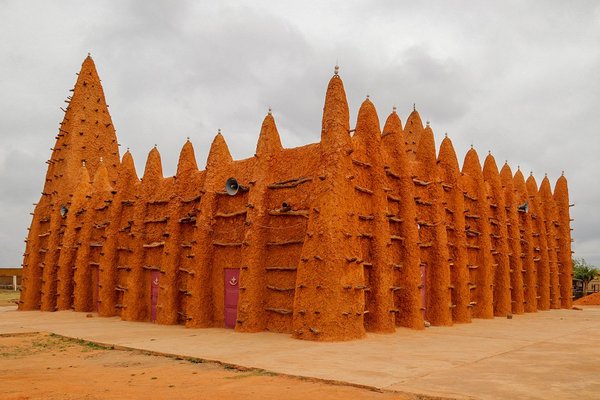Côte d'Ivoire
Sudanese style mosques
The Sudanese style mosques in northern Côte d’Ivoire is a group of eight mosques erected since the 17th century.
They were constructed when Islam spread southwards from North Africa and the Middle East along these trade towns. Their distinct adaption of Sudanese architecture lies in the use of mud brick masonry, with façades reinforced with buttresses and strands, pyramidal towers and cone-shaped minarets. The mosques are still in use.
Community Perspective: Thomas reports on his visit to the mosque of Kong. The other 7 mosques remain unreviewed.
Site Info
Official Information
- Full Name
- Sudanese style mosques in northern Côte d’Ivoire (ID: 1648)
- Country
- Côte d'Ivoire
- Status
-
Inscribed 2021
Site history
History of Sudanese style mosques
- 2021: Advisory Body overruled
- ICOMOS had advised Deferral
- 2021: Inscribed
- Inscribed
- 2006: Revision
- extended from former TWHS Kong (1987)
- Type
- Cultural
- Criteria
- ii
- iv
Links
- UNESCO
- whc.unesco.org
All Links
UNESCO.org
- whc.unesco.org — whc.unesco.org/
Community Information
- Community Category
- Religious structure: Islamic
Travel Information
Recent Connections
-
Smallest cultural WHS
0.12980 ha. -
Fusion
"reflect a fusion of Islamic and local … -
Sudano-Sahelian architecture
Connections of Sudanese style mosques
- Trivia
-
-
Smallest cultural WHS
0.12980 ha.
-
- History
-
-
Trans Saharan trade routes
The mosques "present highly important testimonies to the trans-Saharan trade that facilitated the expansion of Islam and Islamic culture". (Unesco) -
Fusion
"reflect a fusion of Islamic and local architectural forms" (official description)
-
- World Heritage Process
-
-
Extended from original TWHS
Kong (1987)
-
- Religion and Belief
-
-
Notable mosques
8 mosques in a Sudanese architectural style specific to the Sudan or savannah region of West Africa. (AB ev)
-
- Timeline
-
-
Built in the 17th century
Radio-carbon evidence shows that both Sorobango and the small mosque of Kong date back to the 17th-18th centuries, (AB ev)
-
News
No news.
Community Reviews
Show full reviews
Kong in Northeastern Côte d’Ivoire was once upon a time an important trade outpost when the merchants of the huge Mali empire exchanged salt and textiles from the North with slaves, gold and nuts from the South. The city became quite prosperous under the rule of Seku Quattara. Kong was for 150 years capital of the Kong empire, but as of today little has remained except the two incredibly fascinating mosques, built in Sudanese architecture style with ocher-colored clay. The small Barrola mosque and the large more photogenic mosque of Kong, also called “Missiriba”. We had the chance to visit also the interior with its small mihrab oriented towards Mekka, the prayer carpets, stairs leading to the rooftop, but also a colony of small bats lives here. On the practical side, it is best to fly to Korhogo from Abidjan and rent a private vehicle through one of the hotels there, the Olympe Tourist Complex was very helpful with a reliable driver. However, we could not go any further towards Comoé National Park as this part of the country is considered unsafe at present.
Keep reading 0 comments
